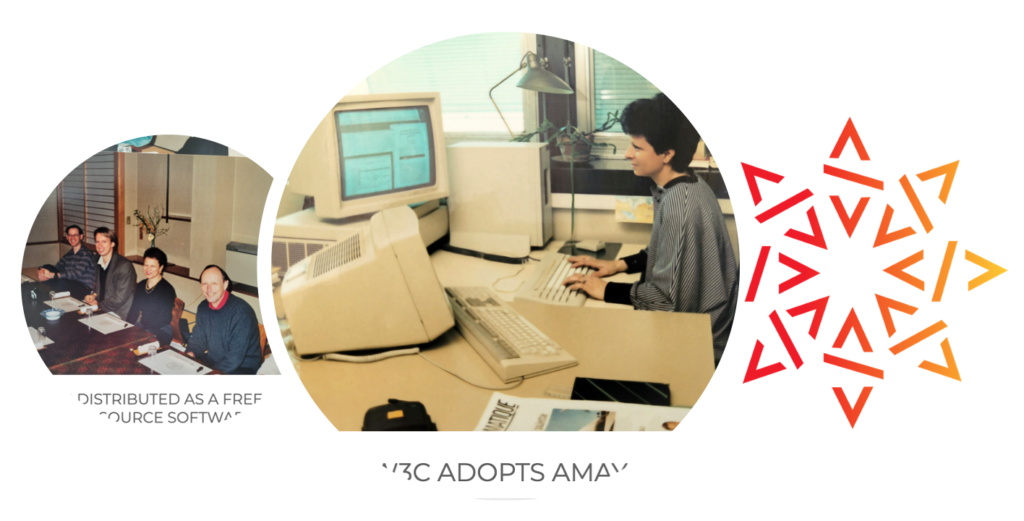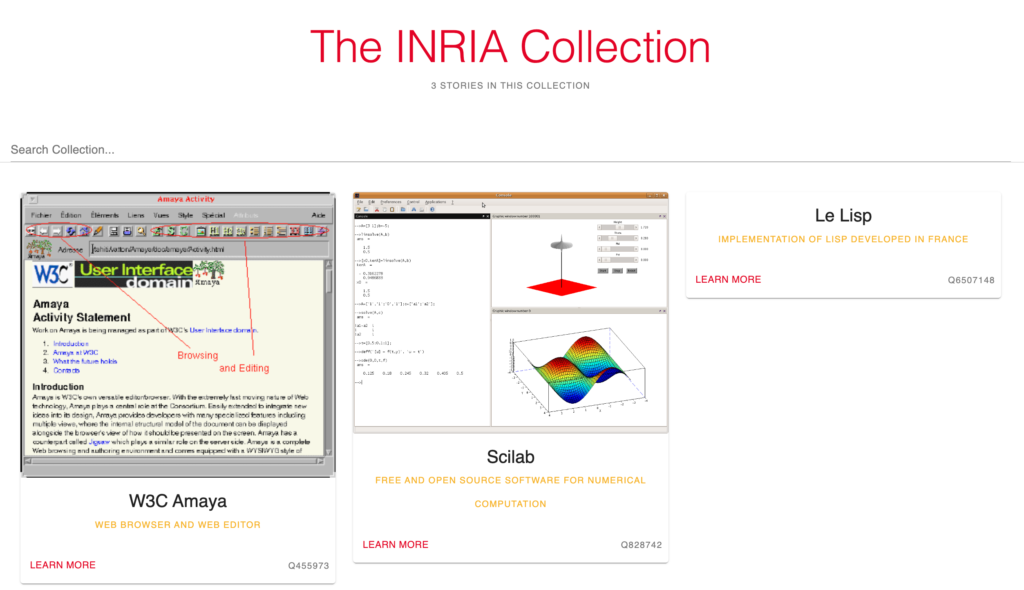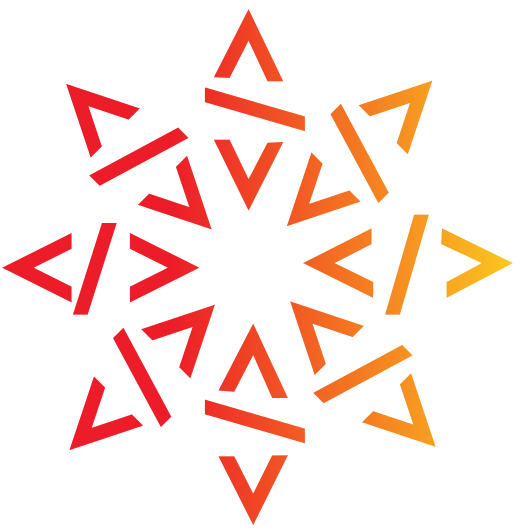Unveiling the Amaya Story: A Pioneering Web Browser and Editor

We are delighted to present a new Landmark Legacy Software Story to Inria’s stories collection: the story of the web browser and editor Amaya.

Preserving landmark legacy software
Software Heritage’s mission is to collect, preserve and share all software source code. Within this mission, there is a category of software which had a profound impact on the evolution of technology and the way we live, work, and innovate. These software artifacts are often hard to find and require human care and curation.
Software source code is the result of a significant part of the intellectual creative efforts of humankind over the last decades, and is becoming an important part of our cultural heritage.
— Paris Call [1]
The preservation of this software is not just a matter of nostalgia; it’s a commitment to our collective digital heritage. It ensures that the knowledge, creativity, and groundbreaking ideas encapsulated within these lines of code remain accessible for future generations. Recovering legacy source code, where the human readable knowledge is kept, is a delicate task. It requires a careful methodology to collect and reconstruct the innovative creation of its authors.
To accomplish this endeavor, the Software Heritage Acquisition Process (SWHAP) [2], established in 2019, was designed as a four step protocol:
- collect,
- preserve,
- curate,
- and present
The Software Stories: the presentation layer
In 2021, Software Heritage launched the Software Stories interface, in collaboration with the Science Stories team and the University of Pisa, with UNESCO’s support [3]. The project leverages information available on Wikidata to present the history of significant historical software projects in an accessible and interactive way.
When Software Heritage launched the Software Stories collection, it was available with the Pisa collection, originating from Pisa University and contributed by Carlo Montangero and Guido Scatena. In the collection we had the following stories:
In 2022, Elisabetta Morri joined this journey and contributed the Magama Lisp story in collaboration with Carlo Montangero to the Pisa collection. Elisabetta has also launched the Inria collection with the first Inria story with Claude Gomez, portraying the Scilab Software Story.
The second addition to the Inria Collection Story was the Le Lisp SWH Software Story, which was created with the assistance of the late Christian Jullien and Jérôme Chailloux.
In May 2023, Mathilde Fichen assumed the responsibility of conducting a survey among Inria alumni and testing the SWHAP process for Inria contributors. With this mission at hand, she has tested the full process with the Amaya software.
Why a new story?
The Software Stories initiative is in a prototyping phase, and creating a new story was the occasion to further define the tools and processes around it and to clarify desired evolution for the Software Stories platform.
Among others, the following questions were addressed:
- How to integrate the creation of a Software Story into the existing SWHAP Guide?
- How to facilitate the creation of a Story by an external party?
- How to make the Software Stories more narrative?
- How can the Software Stories platform evolve technologically to better serve future stories?
What is Amaya?
 Amaya was a web browser and web authoring tool that was developed by Inria and the World Wide Web Consortium (W3C). It was initially released in 1996 and was one of the early web browsers designed to both browse the web and create web content, in line with the original ambition of Tim Berners-Lee for the web. Amaya’s primary purpose was to showcase and promote W3C technologies and standards, such as HTML and CSS.
Amaya was a web browser and web authoring tool that was developed by Inria and the World Wide Web Consortium (W3C). It was initially released in 1996 and was one of the early web browsers designed to both browse the web and create web content, in line with the original ambition of Tim Berners-Lee for the web. Amaya’s primary purpose was to showcase and promote W3C technologies and standards, such as HTML and CSS.
Amaya allowed users to view and edit web pages in a WYSIWYG (What You See Is What You Get) manner, meaning you could see the web page as it would appear in a web browser while editing it. This made it a useful tool for web developers and authors who wanted to create and validate web content according to W3C standards.
Amaya is no longer actively developed, and it has been largely discontinued. Modern web browsers have incorporated many of the features and standards that were once unique to Amaya, making it obsolete.
How was the story created?
Mathilde: I had the chance to be put in touch with Laurent Carcone, a former team member of Amaya and still working for the World Wide Web consortium. Laurent was still connected to Amaya’s historical developers Vincent Quint and Irène Vatton. The three of them helped me to connect the dots of Amaya’s story and to gather pictures and documents of their time with Amaya’s team.
I then assembled a first Software Story on which we could iterate together until we were happy with the result.
Any hurdles?
In my endeavor to make the narrative of Amaya’s story as compelling as possible, I extensively rewrote the initial storyline, which would otherwise have been automatically generated from Wikidata and Wikimedia.
This approach brought its own set of challenges, including the need to source materials that were not readily available on Wikimedia. I invested a considerable amount of time collaborating with Irène, Laurent, and Vincent to gather original content. Additionally, obtaining publishing authorizations from other content owners and websites was a crucial and time-consuming step.
Furthermore, I had to seek out online storage solutions for the collected materials, as this capacity is not currently available within Software Heritage. While images could be stored within the Science Story publisher workspace, this wasn’t the case for other types of materials.
Any learnings?
Process-wise, I believe that the creation of a Software Story benefits greatly from having one dedicated individual responsible for coordinating contributors and managing the practical aspects of creating the story. This approach proved effective in our case.
I was particularly delighted to have the opportunity to interview Vincent Quint during a visit to Paris. I believe this interview adds a highly valuable personal dimension to the Software Story, and I would recommend incorporating such interviews into all future Stories. I ensured that the structure of my interview was not specific to Amaya and could be readily applied to any other software.
— Mathilde Fichen
References
[1] Expert Group Report. Paris call: Software source code as a heritage for sustainable development. Available from https://unesdoc.unesco.org/ark:/48223/pf0000366715, 2019.
[2] Laura Bussi, Roberto Di Cosmo, Carlo Montangero, and Guido Scatena. The software heritage acquisition process. Technical Report CI-2019/WS/8, UNESCO, Università di Pisa, Inria, 2019. https://unesdoc.unesco.org/ark:/48223/pf0000371017
[3] Morane Gruenpeter, Roberto Di Cosmo, Katherine Thornton, Kenneth Seals-Nutt, Carlo Montangero, et al.. Software Stories for landmark legacy code. [Research Report] Inria. 2021. (hal-03483982)[https://hal.science/hal-03483982/]
